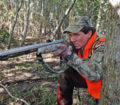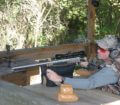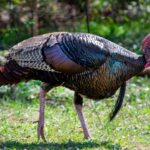John’s Note: The trophy buck is the oldest and the smartest deer on the land you land. Trophy bucks must have eluded hunters for at least 3 years and often for 5-6 six years to become a trophy. He has learned to recognize the mistakes hunters make and understands how and where to hide where hunters can’t find him. If you’re going to take the wide-racked, heavy-antlered, high-tined buck of your dreams with a blackpowder rifle, you must hunt mistake-proof and realize your quarry may be smarter than you are.
I am convinced a deer can recognize the sound of a man walking through the woods. Most of us know the adage, “The slower you go, the more deer you’ll see.” But walking slowly is not enough to prevent a trophy buck from detecting you. We also must camouflage the hunting sounds we make and cause the deer to believe we are animals rather than humans. Many sounds exist in nature. Rarely are the woods silent. If we can use the sounds of nature to hide the sounds we make, we can hunt much more effectively.
 If you ever have heard a turkey moving through the woods, you know the bird sounds much like a man walking most of the time. But those exceptions are what alert a deer to the differences in a hunter and a turkey. A turkey stops, scratches and calls. A man doesn’t. However, we can disguise the sounds of our movements by taking irregular steps and using the toes of our boots to scratch the leaves like a turkey. For instance, take three steps, scratch, wait 30 seconds, then take two steps, scratch, wait, take four steps, and scratch. Add to this cadence soft clucks and yelps with a turkey call, and you will have disguised completely the sound of your walking.
If you ever have heard a turkey moving through the woods, you know the bird sounds much like a man walking most of the time. But those exceptions are what alert a deer to the differences in a hunter and a turkey. A turkey stops, scratches and calls. A man doesn’t. However, we can disguise the sounds of our movements by taking irregular steps and using the toes of our boots to scratch the leaves like a turkey. For instance, take three steps, scratch, wait 30 seconds, then take two steps, scratch, wait, take four steps, and scratch. Add to this cadence soft clucks and yelps with a turkey call, and you will have disguised completely the sound of your walking.
If you trip, stumble or for some reason make a startling noise, use a squirrel call to cover that sound. Squirrels often will leap from a tree to the ground with a loud crash. By imitating the sound of a squirrel, you may be able to hide a major error in your hunting plan. A deer grunt call like the ones produced by Knight & Hale Game Calls (http://www.knightandhale.com/), Haydel’s Game Calls (http://haydels.com/) and Quaker Boy Calls (https://www.quakerboy.com/) also can be utilized to hide the noises you make as you move through the woods. Deer make sounds as they walk, run and cross creeks. By covering or following up the noise you make with deer sounds, you can camouflage your movements.
Besides walking noises, we also make noises hunting from a tree stand. The metal of the stand often scratches the side of the tree as we climb up when using a climbing stand. This sound can be covered in several ways. One of the loudest birds in the woods is a pileated woodpecker. Its high-pitched scream will cause a turkey to gobble and the hair on the back of your neck to stand up if you are close by when it calls. Haydel Game Calls (http://haydels.com), Primos Hunting (http://www.primos.com/) and Knight and Hale Game Calls (http://www.knightandhale.com/) produce a pileated woodpecker call that sounds just like the real thing. By blowing this call each time you move up a tree, you can cover the sound of a tree stand’s moving and biting the trunk. Some other calls to use to hide the sound of a tree stand include squirrel calls and crow calls. A squirrel call like a cutter sounds like a squirrel is cutting a nut, which is a noise that can hide the popping and squirrel-like sounds your tree stand makes when you move to take a shot.
 One of the most-distinctive sounds a blackpowder hunter makes is when he cocks the hammer on his rifle. Even if his rifle is at half-cock when he pulls the hammer back, there will be a click. Although this sound is small, to a trophy buck standing closely in front of you, it will seem to be as loud as a base drum being beaten. When you cock the hammer to shoot, because both hands are involved with raising the rifle and cocking the hammer, using a call is almost impossible. However, this problem can be solved in the same way a hunter solves the problem of having a wild turkey in close and wanting to call to the bird without his seeing the hunter move. Use a diaphragm turkey call to cover the cocking sound made by your rifle. Since turkeys often perch in trees, clucking and yelping, these sounds are natural for deer to hear.
One of the most-distinctive sounds a blackpowder hunter makes is when he cocks the hammer on his rifle. Even if his rifle is at half-cock when he pulls the hammer back, there will be a click. Although this sound is small, to a trophy buck standing closely in front of you, it will seem to be as loud as a base drum being beaten. When you cock the hammer to shoot, because both hands are involved with raising the rifle and cocking the hammer, using a call is almost impossible. However, this problem can be solved in the same way a hunter solves the problem of having a wild turkey in close and wanting to call to the bird without his seeing the hunter move. Use a diaphragm turkey call to cover the cocking sound made by your rifle. Since turkeys often perch in trees, clucking and yelping, these sounds are natural for deer to hear.
I don’t use a deer call when a buck’s in close enough to shoot, because I don’t want the buck to look up and spot me in a tree. If you hunt in an area where the deer grunt call is commonly blown, a trophy buck soon will learn to look first for a hunter in the trees who’s making that sound. If the buck doesn’t spot the hunter, then he will begin to search for the other deer he assumes are grunting. However, in the fall of the year during an early blackpowder season, rarely will deer look up after you give turkey calls to cover your unnatural sounds.
To get John E. Phillips’ eBooks, audio books and print books on hunting deer, including his newest deer-hunting book, “Whitetail Deer and the Hunters Who Take Big Bucks,” available at http://amzn.to/2bYwYOK/, click on these books to learn more, “How to Hunt and Take Big Buck Deer on Small Properties,” “How to Hunt Deer Up Close: With Bows, Rifles, Muzzleloaders and Crossbows,” “PhD Whitetails: How to Hunt and Take the Smartest Deer on Any Property,” “How to Take Monster Bucks,” “How to Hunt Deer Like a Pro,” and “Bowhunting Deer: Mossy Oak Pros Know Bucks and Bows,” or to prepare venison, “Deer & Fixings.” Or, go to www.amazon.com/kindle-ebooks, type in the name of the book, and download it to your Kindle, and/or download a Kindle app for your iPad, SmartPhone or computer. You also can find John’s books on Nook at www.barnesandnoble.com.
For free information on making jerky from your deer to provide a protein-rich snack, you can download a free book from https://johninthewild.com/free-books.










